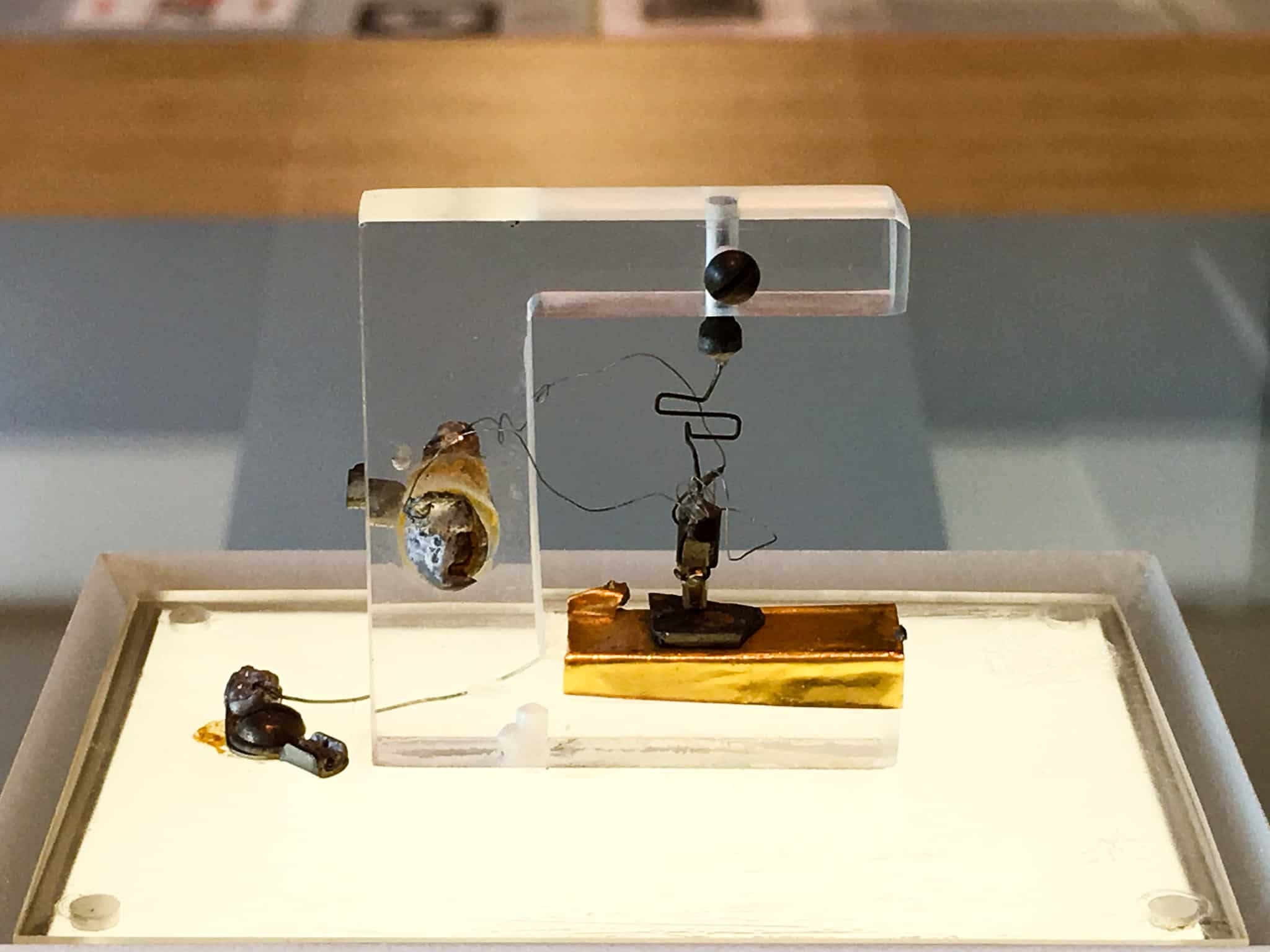
Design of semiconductor transistor
©CatKillerroddhullandemu@modi, CC BY-SA 3.0, via Wikimedia Commons – Original / License
4 Facts about the Semiconductor Transistor
- A semiconductor transistor is a device used to amplify or switch electrical impulses.
- The transistor is a fundamental component of modern electronics, and contains three terminals to connect to an electric circuit.
- In 1956, the Nobel Prize in Physics was given for creating the transistor which has been recognized as one of the most important inventions of the twentieth century.
- The transistor was invented with John Bardeen, Walter Brattain, and William Shockley from Bell Labs.
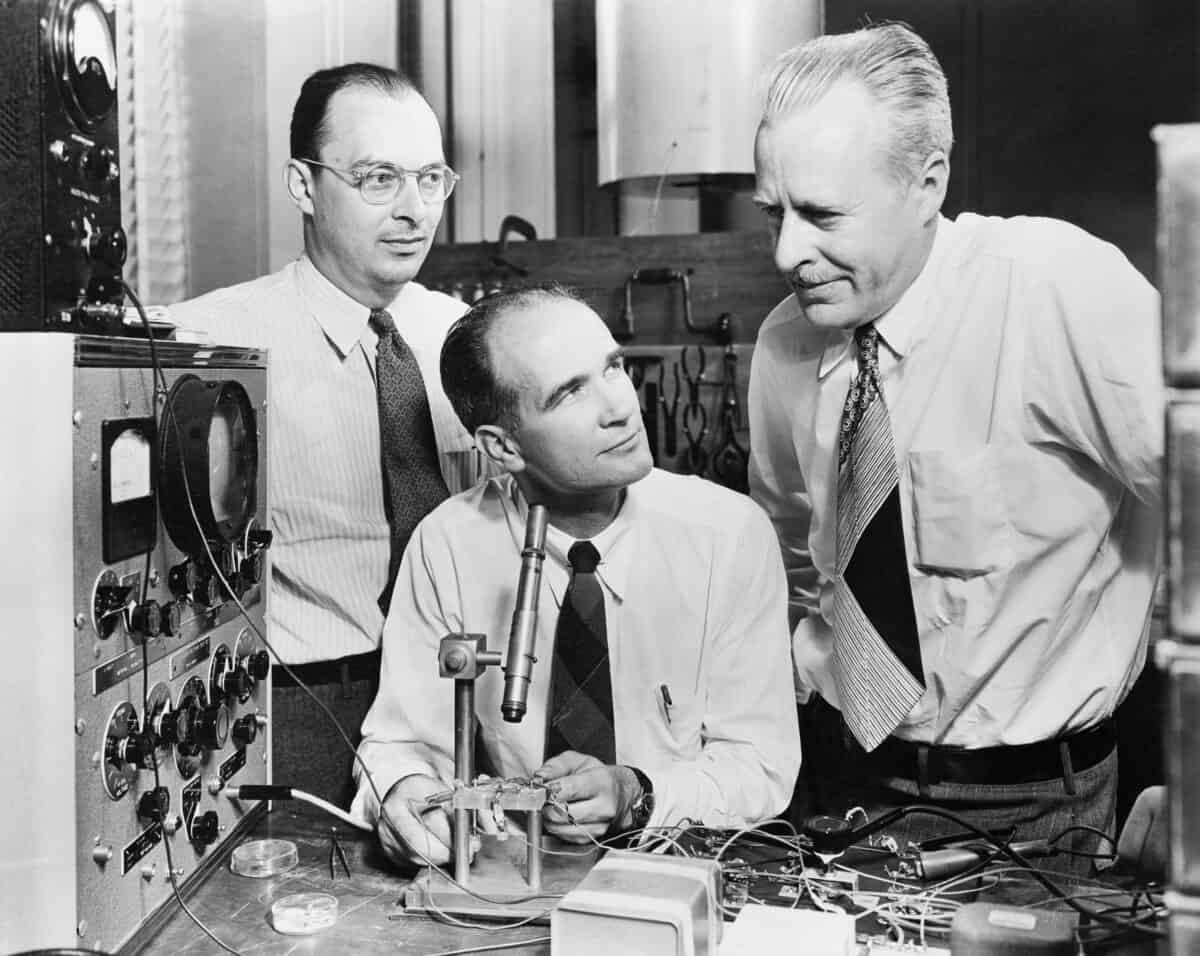
Bardeen, Shockley and Brattain – Inventors of semiconductor transistor
©AT&T; photographer: Jack St. (last part of name not stamped well enough to read), New York, New York., Public domain, via Wikimedia Commons – Original / License
Semiconductor Transistor History
Alessandro Volta was the first to use “semiconducting” in 1782. In 1833, Michael Faraday was the first to notice a semiconductor effect.
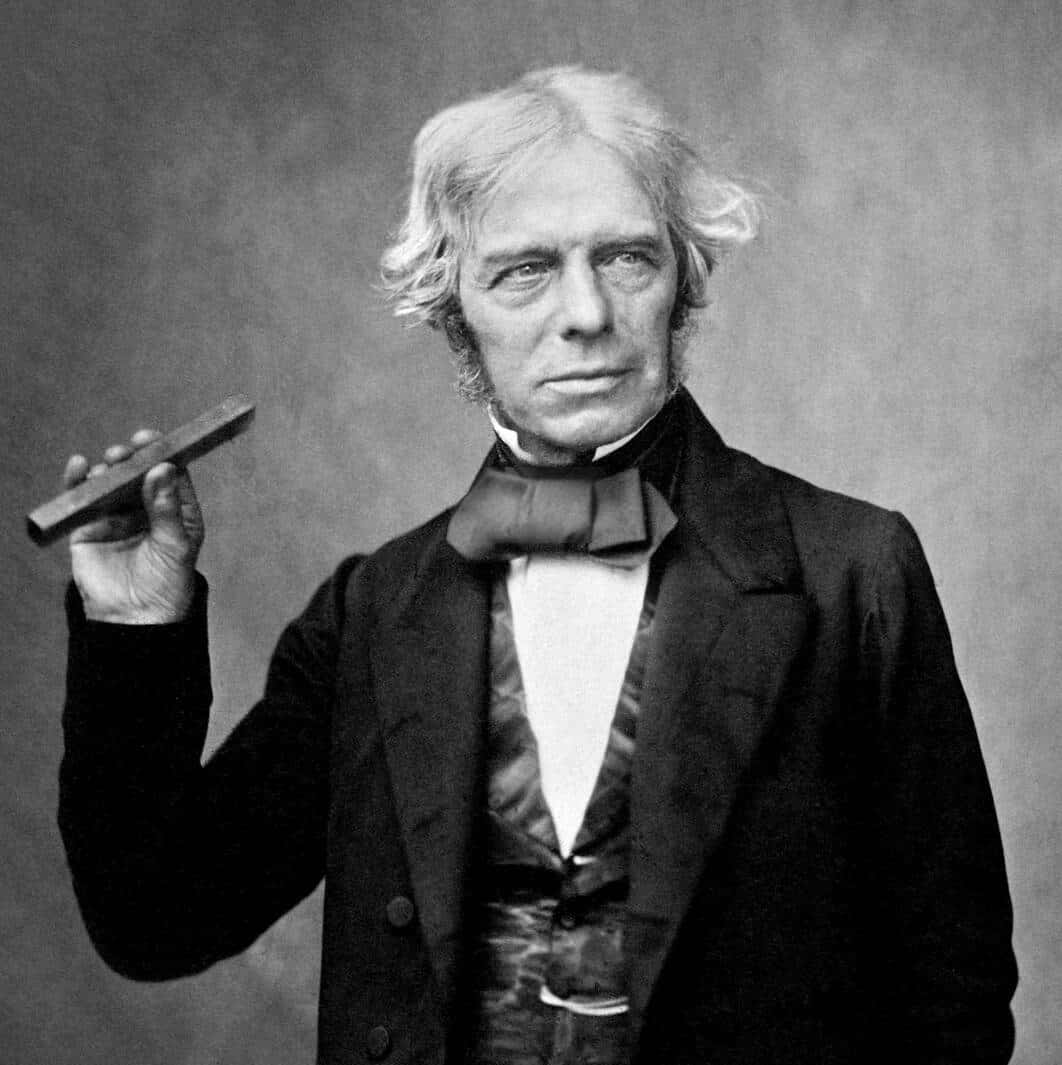
Michael Faraday was the first to notice a semiconductor effect.
©Maull and Polyblank, Public domain, via Wikimedia Commons – Original / License
The electrical resistance of silver sulfide decreases with temperature, according to Faraday. Karl Braun found and described the first semiconductor diode effect in 1874. Braun discovered that current flowed freely in just one direction at the contact between a metal point and a galena crystal.
Quick Facts
- Created
- December 16, 1947
- Creator
- William Shockley, John Bardeen, Walter Brattain
- Original Use
- To amplify or switch electronic signals
- Cost
- $1 in 1960 – about $8 today
The next significant contributor to semiconductor field is the French experimental physicist Edmond Becquerel. In 1839, he reported the observation of photovoltage in the silver chloride coated platinum electrodes. In his experiment, a AgCl coated platinum electrode was immersed in an aqueous nitric acid electrolyte solution. Illumination of the electrode generated photovoltage that altered the EMF produced by the cell, in fact, it produced a reductive (cathodic) photocurrent at the AgCl coated electrode; this was the first reported photovoltaic device. Photovoltage was generated at the Ag/AgCl metal semiconductor contact.

Willoughby Smith discovered that resistance actually depended on the intensity of incident light.
In 1873, the English electrical engineer Willoughby Smith (1828-1891) (see the nearby portrait) arrived at the discovery of photoconductivity of selenium. He was initially working with submarine cables. He set into experiments with selenium for its high resistance, which appeared suitable for his submarine telegraphy. Various experimenters measured the resistance of selenium bars, but the resistance as measured by them under different conditions did not agree at all. Then Smith discovered that the resistance actually depended on the intensity of incident light. When the selenium bars were put inside a box with the sliding cover closed, the resistance was the highest. When glasses of various colors were placed in the way of light, the resistance varied according to the amount of light passing through the glass. But when the cover was removed, the conductivity increased. He also found that the effect was not due to temperature variation.

Ferdinand Braun discovered the rectification effect at the point of contact between metals and certain crystal materials.
©Public domain, from Wikimedia Commons, the free media repository – Original / License
In 1874, the German physicist Ferdinand Braun (see the nearby portrait), a 24-year old graduate of the University of Berlin, studied the characteristics of electrolytes and crystals that conduct electricity at Würzburg University. When he probed a galena crystal (lead sulfide) with the point of a thin metal wire, Braun noted that current flowed freely in one direction only. He had discovered the rectification effect at the point of contact between metals and certain crystal materials.
Braun demonstrated this semiconductor device to an audience at Leipzig on November 14, 1876, but it found no useful application until the advent of radio in the early 1900s when it was used as the signal detector in a “crystal radio” set. The common descriptive name “cat’s-whisker” detector is derived from the fine metallic probe used to make electrical contact with the crystal surface. Braun is better known for his development of the cathode ray tube (CRT) oscilloscope in 1897, known as the “Braun tube” (Braunsche Röhre in German). He shared the 1909 Nobel Prize with Guglielmo Marconi for his contributions to the development of wireless telegraphy, mainly the development of tunable circuits for radio receivers.

Between 1902 and 1906, the American Telephone and Telegraph electrical engineer Greenleaf Whittier Pickard (1877-1956) (see the nearby portrait) tested thousands of mineral samples to assess their rectification properties. Silicon crystals from Westinghouse yielded some of the best results. On August 20, 1906, he filed a U.S. patent on “Means for receiving intelligent communication by electric waves” for a silicon point-contact detector (diode) and it was awarded that November (see the U.S. patent 836531 of Pickard). With two associates, Pickard founded the Wireless Specialty Apparatus Company to market “cat’s-whisker” crystal radio detectors. It was probably the first company to make and sell silicon semiconductor devices. Another American inventor—Henry Dunwoody received a patent on a system using a point-contact detector made of carborundum (silicon carbide) only several weeks after Pickard.
In 1915 the American physicist Manson Benedicks discovered that a germanium crystal can be used to convert AC (alternating current) current into DC (direct current), i.e. the rectifying properties of germanium crystals. Thus the germanium was added to the list of semiconductors. Till then, it was a short list consisting of silicon, selenium, and tellurium.
In 1927 the Americans L.O. Grondahl and P.H. Geiger invented the copper oxide rectifier. The U.S. Patent 1640335 was issued on August 23rd, 1927, to Grondahl.
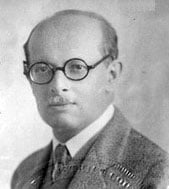
In 1925 the famous inventor Julius Lilienfeld (see the nearby photo) filed an application for patent in Canada, next year in USA, describing a device, very similar to a MESFET transistor, which he called then Method and Apparatus for Controlling Electric Currents (see the US patent 1745175 of Lilienfeld).
Julius Edgar Lilienfeld (1882–1963) was a remarkable person in the field of physics and electronics. The Austrian Jew Lilienfeld was born in Lemberg in Austria-Hungary (now called Lviv in Ukraine). He was educated (PhD in physics) and lived in Germany till the middle of 1920s, when he decided to emigrate to USA. Besides the abovementioned patent for the first transistor, he was a holder of several other patents in this field—US patent 1900018 “Device for controlling electric current” from 1928 for a thin film MOSFET transistor; US patent 1877140 “Amplifier for electric currents” from 1928, for a solid state device where the current flow is controlled by a porous metal layer, a solid state version of the vacuum tube; US patent 2013564 “Electrolytic condenser” from 1931, for the first electrolytic capacitor. When Brattain, Bardeen and Shockley tried to get a patent on their transistor, most of their claims were rejected namely due to the Lilienfeld patents.

In 1934 another German scientist—Oskar Heil (1908–1994), electrical engineer and inventor, applied for a German patent for an early transistor-like device, describing the possibility of controlling the resistance in a semiconducting material with an electric field, which he called Improvements in or relating to electrical amplifiers and other control arrangements and devices. In 1935 Heil received a British (see the nearby drawing from the Britsh patent), Belgian and French patents for his device.
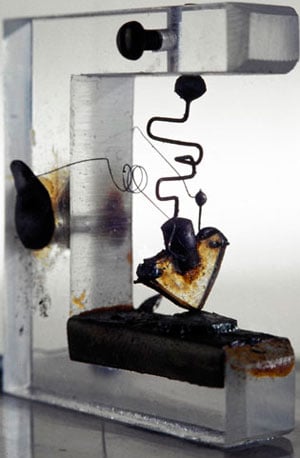
The first semiconductor device, named “cat whiskers,” was invented in 1901 by Jagadis Chandra Bose. Cat whiskers was a radio wave detector that used a point-contact semiconductor rectifier.
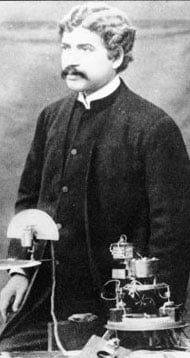
A transistor is a semiconductor material-based device. In 1947, the transistor was invented by John Bardeen, Walter Brattain, and William Shockley.
John Bardeen was an engineer and physicist from the United States. He is the only individual who twice received the Nobel Prize in Physics. Walter Houser Brattain worked at Bell Labs as a physicist. Brattain spent most of his time studying surface states. In the 1970s, Walter was an enthusiastic member of the Walla Walla Country Club until he died in 1987. William Bradford Shockley Jr. was an American physicist and inventor. He was the manager of a Bell Labs research group.
John Bardeen and Walter Brattain of AT&T’s Bell Labs in Murray Hill, New Jersey, conducted experiments from November 17, 1947, to December 23, 1947. They discovered that when two gold point contacts were applied to a germanium crystal, a signal was produced with output power more significant than the input. William Shockley, the Solid State Physics Group chief, saw the potential and spent the next few months working to increase semiconductor expertise dramatically. As a result, John R. Pierce invented the name transistor to contract the phrase trans-resistance.
William Bradford Shockley, John Bardeen, and Walter Houser Brattain shared the Nobel Prize in Physics in 1956 for “researches on semiconductors and the discovery of the transistor effect.”

William Bradford Shockley shared the Nobel Prize in Physics in 1956 for “researches on semiconductors and the discovery of the transistor effect.”
©Michael Vi/Shutterstock.com
Semiconductor Transistor: How It Worked
A transistor can control a considerably larger signal at another pair of terminals with a bit of signal applied between one set of terminals. Gain is the name for this property. It can act as an amplifier by producing a more robust output signal like a voltage or current proportionate to a weaker input signal. Alternatively, the transistor can be an electrically controlled switch to turn the current on or off in a circuit. The amount of current is determined by other circuit parts.
A transistor is made up of two P-N junctions stacked on top of each other. One is forward biased, namely the base-emitter junction, whereas the other is reverse biased, namely the base-collector junction. Even though the base-collector link is reverse biased, it is discovered that when a current is forced to flow in the base-emitter junction, a more considerable current flows in the collector circuit.
An NPN transistor is used as an example for clarification. In a PNP device, the same principle applies, only that instead of electrons, holes are the majority carriers. Electrons leave the emitter and enter the base when the current runs via the base-emitter junction. However, doping in this region is kept to a minimum, and there are few recombination gaps.
As a result, most electrons can pass past the base region and into the collector zone, drawn by the positive potential. Only a tiny percentage of the emitter’s electrons combine with holes in the base region, resulting in a current in the base-emitter circuit. The collector current is substantially higher as a result of this.
Semiconductor Transistor: Historical Significance
Bell Telephone Laboratories invented the transistor in 1948. The transistor’s invention was a significant moment in the history of electronics as it signaled the start of the current era in the electronics industry.
The transistor revolutionized the electronics industry, allowing the development of nearly every modern electronic device, from phones to computers, and ushering in the Information Age. Semiconductors are known to be the brains of modern electronics. Semiconductors are a vital component of electronic equipment, allowing for advancements in communications, computers, healthcare, military systems, transportation, clean energy, and various other fields.
Semiconductor transistors hold this much significance due to their extensive usage. Some of the significant uses are as follows.
Electronic switches are made of transistors. They can turn currents on and off at a rate of billions of times per second. Transistors are the primary mechanism for storing and transporting data in digital computers. In addition, transistors can be used as amplifiers if they are set up correctly. This property is used in the great majority of audio and other signal amplifiers.
Up Next…
- Computer Mouse: Complete History From a box-like prototype to the sleek modern wireless design used today, the computer mouse has an interesting history.
- The 15 Largest Cybersecurity Companies In The World, And What They Do Cybersecurity has never been more important than today. Learn about the 15 most influential Cybersecurity companies in the world.
- What is Steam Deck? Good question. Find out all you ever wanted to know about Steam Deck in this informative read.
The image featured at the top of this post is ©Jeff Keyzer (mightyohm) / CC BY-SA 2.0, Flickr.
